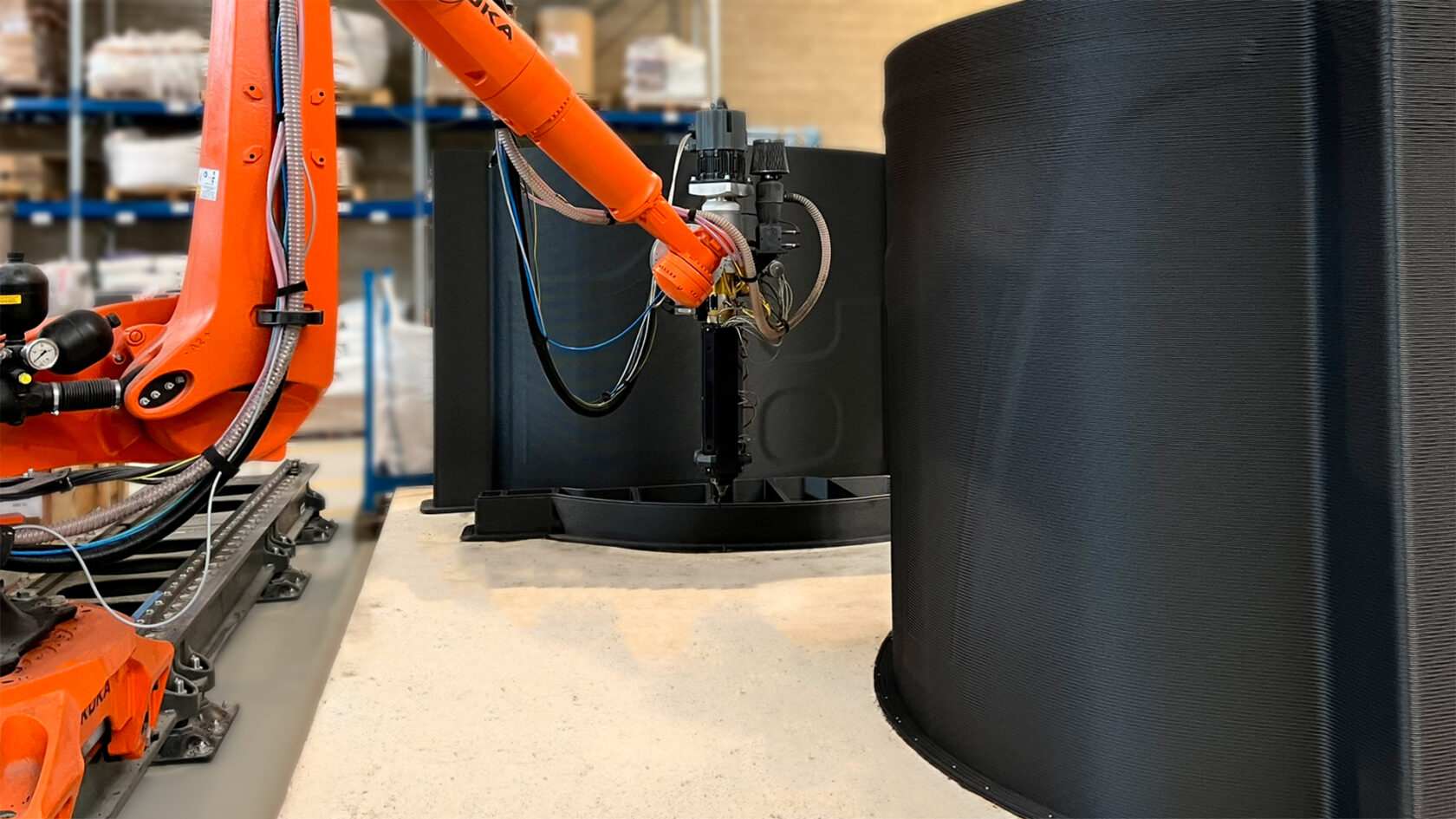
LFAM technology like Caracol’s has been driving innovation in advanced manufacturing supply chains, such as in the aerospace, energy, and automotive, industries by advancing 3D printing tooling that offers greater design flexibility, faster production, and improved efficiency, outperforming traditional methods in performance.
Caracol’s turnkey LFAM robotic technology – Heron AM – enables the production of large and complex tools with composite materials achieving several process benefits, from costs to sustainability to weight, compared to traditional methods. Heron’s ability to print with virtually no limits in size, leveraging the robot’s +6 axes provide greater flexibility in tools production by eliminating the need for assemblies, significantly reducing material used and waste, and drastically speeds up production time.
Caracol has successfully demonstrated these advantages through various applications, producing robust and high-performance tools tailored to meet specific industrial needs.
1. Trim and drill jigs applications
Traditional manufacturing methods, even if capable of providing the precision necessary to meet the rigorous standards of the aerospace industry, have significant inefficiencies aspects and a high environmental impact. These processes require the use of different metal alloys, such as Invar and Aluminum, to make a single component, as well as complex welding and assembly steps, and complicated management of raw material supplies.
As a result, the aerospace industry faces high costs, highly labor-intensive processes and long lead times.
These critical issues are amplified in the production of specialized tools, such as trimming and drilling jigs, which are critical for assembly and maintenance. Making these tools requires long production cycles and extremely accurate manual labor, further slowing down processes.
LFAM technology provides an innovative alternative for aerospace tooling, allowing composite and lightweight tools to be produced in a single process, dramatically reducing assembly needs and lead times. 3D printing also offers greater design flexibility, faster production times, and the use of advanced, recyclable thermoplastic materials optimized for the specific needs of the aerospace industry.
Below are two examples of 3D printed tools that show how the adoption of Heron AM in the production of trimming and drilling tools can boost efficiency within the aerospace industry.
Positioning jigs – key facts:
- SYSTEM: Heron 400
- EXTRUDER: High Flow (HF)
- NOZZLE SIZE: 12 mm
- MATERIAL: ABS + 30% Glass Fiber
- POST-PROCESSING: Machining
- SIZE: 1800 x 1600 x 700 mm (single piece)
- WEIGHT: 400 Kg (single piece)
- PRINT TIME: 16 hrs (single piece)
- WEIGHT REDUCTION: 70%
- LEAD TIME REDUCTION: 80%
- COST REDUCTION: 30%
Trim and drill tool – key facts:
- SYSTEM: Heron 400
- EXTRUDER: High Flow (HF)
- NOZZLE SIZE: 12 mm
- MATERIAL: ABS + 20% Carbon Fiber
- POST-PROCESSING: Machining
- SIZE: 1700 x 1500 x 2200 mm
- WEIGHT: 600 Kg
- PRINT TIME: 30 hrs
- WEIGHT REDUCTION: 70%
- LEAD TIME REDUCTION: 80%
- COST REDUCTION: 30%
2. Autoclave cure tools
The automotive industry faces several challenges in producing autoclave curing tools, which are essential for processing composite parts such as carbon fiber parts. Traditional methods often involve bonding multiple resin or metal plates together to achieve the required volume, followed by milling the surface. This process results in high production complexity, higher material consumption, increased manual labor and, consequently, longer lead times.
Caracol proposes an innovative solution through 3D printing, offering lightweight Direct Molds with complex geometries made in one piece from advanced thermoplastic materials. Heron AM technology enables highly flexible design, optimizing shapes already at the engineering stage, minimizing the material used and significantly accelerating production time. This approach makes the process more efficient, sustainable and adaptable to industry needs.
In addition, autoclave 3D printing tooling is characterized by the use of advanced materials that provide greater durability and resistance to the extreme conditions of autoclave cycles, thus improving the overall efficiency of automotive manufacturing.
Following a successful case study from Caracol highlighting the advantages of 3D printing in manufacturing a Direct Mold that is ideal for small batch production of automotive components.
Key facts:
- SYSTEM: LFAM Heron 400 with HF extruder
- NOZZLE SIZE: 12mm
- MATERIAL: PC + 20% Carbon Fiber
- POST-PROCESSING: Machining + Autoclave
- SIZE: 1700 x 2000 x 1000 mm
- WEIGHT: 700 Kg
- PRINT TIME: 37 hrs
- WEIGHT REDUCTION: 70%
- WASTE REDUCTION: 60%
- LEAD TIME REDUCTION: 70%
- COST REDUCTION: 20%
3. Lamination tool for micro wind blades
Tooling is essential to produce lightweight, high-performance blades, which often require precise designs and complex geometries to optimize aerodynamic efficiency. Traditional manufacturing methods, such as machining and casting, struggle to meet these requirements and remain efficient due to long lead times, high material waste, and limited design flexibility.
3D printing tooling for RTM production of rolling parts is a state-of-the-art solution, enabling the production of customized rolling tools in one piece. LFAM reduces material waste, shortens production cycles, and enables the use of advanced recyclable materials designed to withstand the harsh environmental conditions of wind turbines.
The following section shows a successful project implemented by Caracol (in collaboration with Deremco, Acus, and Carbon Cleanup), where the adoption of Heron AM increased design flexibility, enabled faster prototyping, and improved the overall production cycle of micro wind turbines.
Key facts:
- SYSTEM: LFAM Heron 400 with HF extruder
- NOZZLE SIZE: 12mm
- MATERIAL: ABS + 20% recycled Carbon Fiber
- POST-PROCESSING: Machining + Lamination
- SIZE: 1450 x 450 x 2200 mm
- WEIGHT: 400 Kg
- PRINT TIME: 24 hrs
- WEIGHT REDUCTION: 85%
- LEAD TIME REDUCTION: 75%
- COST REDUCTION: 55%








































